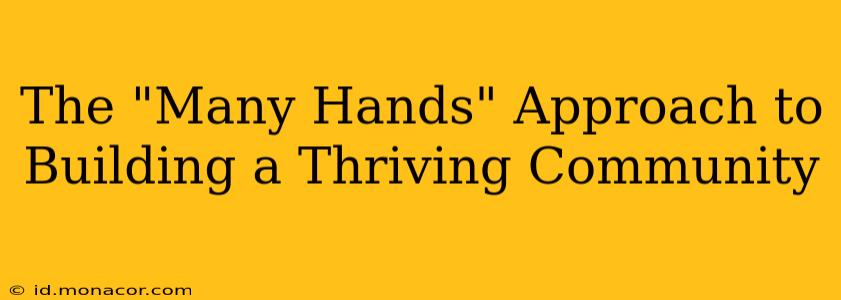Building a thriving community isn't a solo act; it's a symphony of shared effort and collective contribution. The "many hands" approach emphasizes the power of distributed leadership and widespread participation, fostering a sense of ownership and belonging that's essential for long-term success. This approach moves beyond a top-down structure, embracing inclusivity and empowering members to shape the community's direction and growth. This article will explore the key principles and strategies behind this powerful model, offering insights on how to cultivate a vibrant and sustainable community.
What are the key elements of a successful "many hands" community?
A truly successful "many hands" community relies on several interconnected elements. These include a clearly defined purpose and shared values, effective communication channels, diverse opportunities for involvement, and a strong emphasis on mutual support and respect. It's about creating a space where everyone feels valued and empowered to contribute their unique skills and perspectives. This distributed leadership model ensures that the community isn't reliant on a single individual, fostering resilience and longevity.
How can you encourage participation and foster a sense of ownership within a community?
Encouraging participation and fostering a sense of ownership are crucial for a thriving community. This can be achieved through several strategies. First, establish clear pathways for engagement, making it easy for members to contribute in ways that align with their skills and interests. Secondly, regularly solicit feedback and input from members, demonstrating that their opinions and contributions are valued. Thirdly, celebrate successes and acknowledge contributions publicly, reinforcing positive behavior and strengthening community bonds. Finally, empower members to take on leadership roles, fostering a culture of shared responsibility and growth.
What are the challenges of using a "many hands" approach, and how can they be overcome?
While the "many hands" approach offers significant advantages, it's not without its challenges. One potential hurdle is coordinating efforts and ensuring consistency across various initiatives. This can be addressed by establishing clear communication protocols and using collaborative tools to streamline workflows. Another challenge is managing disagreements and resolving conflicts that may arise. Developing a robust conflict resolution process and fostering a culture of mutual respect and understanding are crucial in overcoming this obstacle. Finally, ensuring equitable distribution of tasks and avoiding burnout among active members requires careful planning and a commitment to balance and fairness.
How can you measure the success of a "many hands" community?
Measuring the success of a "many hands" community goes beyond simple metrics like membership numbers. Key indicators include active participation rates, the diversity of contributions, member satisfaction, and the community's ability to achieve its shared goals. Qualitative data, such as member feedback and case studies of successful collaborations, offer valuable insights into the overall health and effectiveness of the community. Tracking these metrics helps to identify areas for improvement and ensures the community remains vibrant and sustainable over the long term.
What are some examples of successful "many hands" communities?
Numerous successful communities exemplify the power of the "many hands" approach. Open-source software projects, for instance, rely on the collective efforts of thousands of developers worldwide to create and maintain software. Online forums and communities built around shared interests also often thrive through the collaborative contributions of their members. These examples highlight the ability of distributed leadership and widespread participation to foster innovation, build strong relationships, and achieve common goals.
How do you handle conflict within a "many hands" community?
Conflict is inevitable in any community, but in a "many hands" environment, proactive conflict resolution is especially critical. Establishing clear guidelines for communication and interaction, providing training on conflict resolution techniques, and fostering a culture of empathy and understanding are essential steps. A transparent and fair process for addressing disagreements, involving impartial mediators when necessary, is key to maintaining a positive and productive community environment.
Conclusion: Building a Community Through Collective Action
The "many hands" approach is a powerful strategy for building thriving communities. By fostering inclusivity, empowering members, and promoting collaboration, this model unleashes the collective potential of a diverse group of individuals, leading to a vibrant, resilient, and ultimately, more successful community. It’s about recognizing the value of every contribution and building a shared future through collective action.

